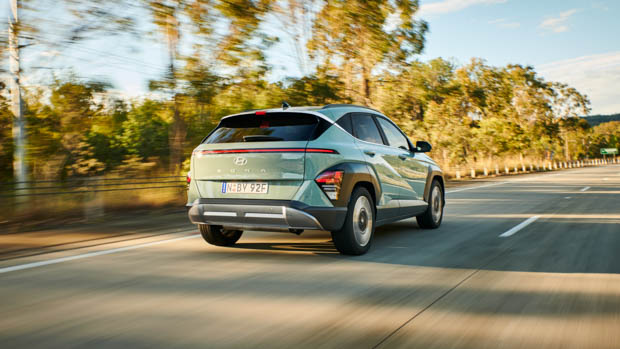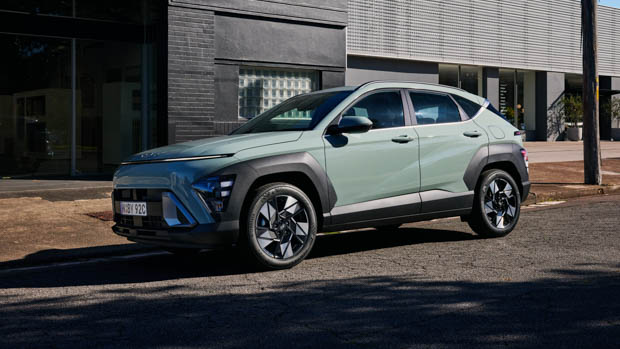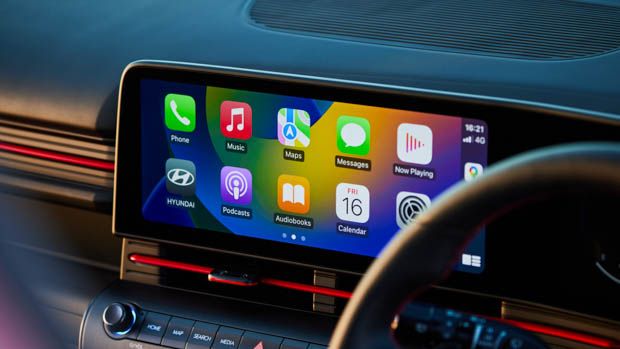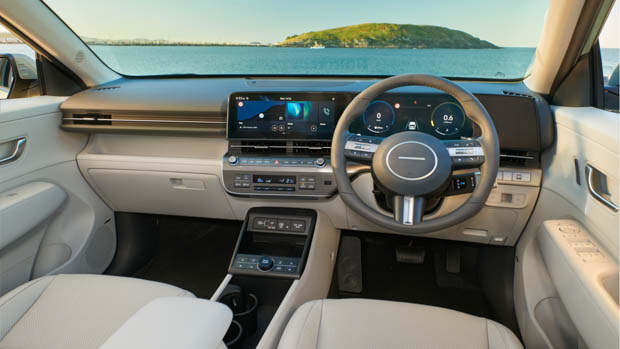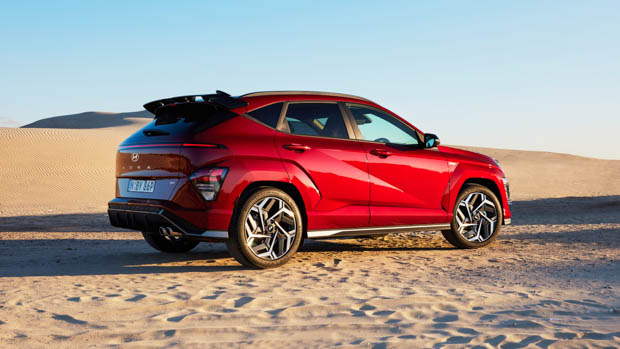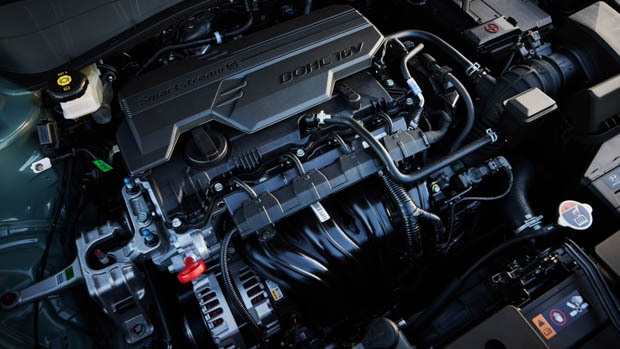-
Car Reviews
- All reviews
- Midsize SUVs
- Small cars
- Utes
- Small SUVs
- Large SUVs
- Large cars
- Sports SUVs
- Sports cars
- Vans
Latest reviews
- Car News
-
Car Comparisons
Latest comparisons
- Chasing Deals
Taking a substantial step up in price and size, the first of many new-gen Hyundai Konas have arrived with a host of turbocharged AWD, hybrid and fully-electric options
Hyundai Australia has laid out the full pricing and specifications for its new-generation Kona small SUV, which is set to kick off from $32,000 before on-road costs.
Now available in two grades known as ‘Kona’ and ‘Kona Premium’, the new small SUV range will also be offered with four powertrain options consisting of a base 2.0-litre engine, a 1.6-litre hybrid, a turbocharged 1.6-litre engine with all-wheel drive and a BEV version.
As is the case with the Tucson midsize SUV, the Kona now offers the sporty ‘N-Line’ styling as an option rather than a grade, with the pack fitted as standard on the AWD model.
The new generation comes with a whopping $5100 increase to the price of entry over the outgoing range, while the tree-topping Kona Premium with the N-Line pack is $3300 more expensive than the outgoing petrol-driven equivalent.
Hyundai has confirmed that the base 2.0-litre engine and the 1.6-litre turbo AWD models are now in the country.
The 1.6-litre hybrid and the fully-electric versions are set to arrive in the fourth quarter of this year, between October and December.
Compared to the outgoing first-generation Kona, the new iteration of the small SUV has grown 30mm taller and 145mm longer, 60mm of which has gone into extra wheelbase.
Hyundai says the main benefit of this increase is for the space inside, with claims of more hip, shoulder, head and leg room, plus a larger boot capacity that has grown by 33L to up to 407L in size.
This increase in size sees the Kona firmly plant itself among the ‘upper large’ small SUVs in the segment, alongside Toyota Corolla Cross, Subaru Crosstrek and the closely related Kia Niro.
Those of you with eyes will have spotted the refreshed exterior design of the 2023 Kona, with the interior also getting a significant redesign that includes a more modern and minimalist design that draws your attention to a pair of large multimedia displays.
Hyundai says the second-generation Kona is based on its new K-platform that builds alongside a series of other incremental changes to improve refinement, safety and the driving experience.
While the new model hasn’t been equipped with a locally-developed suspension and steering tune, the Australian arm of Hyundai says it was heavily involved in the development of the Kona from the early stages of development.
Hyundai Australia says this inclusion with the project R&D allowed the Kona to be massaged to Australian wants and needs, but that’s a claim that will have to wait to assess in a full review.
In terms of technology, the Kona will become the first Hyundai to feature wireless Apple CarPlay and Android Auto on a model with proprietary navigation, displayed upon a 12.3-inch screen. You can read more about this issue in our separate article.
Hyundai has also integrated its Bluelink technology into the Kona, which unlocks a host of features that you can also read about in our dedicated article.
Kona
On the outside, the standard Kona is dressed with LED headlights and tail-lights, heated and folding mirrors, 18-inch wheels and a new spoiler tapering the sloped rear-end design.
The interior of the Kona is trimmed in cloth material in a shade of Obsidian Black, though the steering wheel and shift knob are wrapped in leather as standard. The front seats feature height adjustment with adjustable lumbar support for the driver only.
Other highlight features include the 12.3-inch touchscreen multimedia display, joined by an additional 4.2-inch display between two analogue dials in the driver’s binnacle. The dual-zone climate control system includes air vents in the second row.
Safety has also taken a big jump with the Kona now featuring seven airbags as standard that includes a front-centre airbag. These join front and rear parking sensors, blind-spot collision avoidance, adaptive cruise control with stop-and-go and safe exit assist to name a few.
Kona Premium
Stepping up to the Kona Premium adds a larger 12.3-inch fully-digital instrument cluster, which integrates the blind-spot view monitor, plus other tech features like an eight-speaker Bose sound system and built-in navigation.
The interior upholstery is appointed in leather, which can be had in a choice of Obsidian Black, Light Shale Grey and Sage Green.
In the front row, occupants benefit from heated and ventilated seats, with the driver accessing 10-directions of seat adjustment, a heated steering wheel and a relaxation mode, while the passenger gets eight-ways of power adjustment. The second row seating is also heated.
Other features include a power tailgate, dual projector beam LED headlights, rear privacy glass, rain-sensing wipers, ambient lighting with additional safety add ons including reversing AEB and a 360-degree camera.
A sunroof, power sunshades and a cloth knit headlining are also available as an option.
N-Line pack
The N-Line package can be added to both grades and throws on a slew of more aggressive styling trimmings including larger 19-inch wheels on all model types bar the 1.6-litre hybrid.
To add sportiness to the N-Line, Hyundai adds N badges across the exterior, a chrome twin-tip exhaust, black mirror caps and spoiler, those dual projector LED headlights (for base Kona) plus body-coloured cladding.
On the inside, buyers benefit from a mixture of leather and Alcantara trim with perforation on the steering wheel, the larger 12.3-inch digital instrument cluster and rain-sensing wipers (for base Kona).
The Kona range begins with the entry-level 2.0-litre naturally aspirated four-cylinder engine option, which now sends its 110kW/180Nm through a CVT automatic to the front wheels. These versions come with claimed 6.6L/100km average fuel economy.
Stepping up to the 146kW/265Nm 1.6-litre turbocharged four-cylinder option adds an eight-speed automatic transmission and all-wheel drive which brings more grunt, though efficiency drops to 7.6L/100km claimed.
The Kona Hyundai hybrid powertrain makes use of a naturally aspirated version of this 1.6L engine coupled with a six-speed dual-clutch transmission that sends 104kW/265Nm to the front wheels only.
Efficiency for the hybrid is stated at an impressive 3.9L/100km, which is just 0.1L/100km shy of the front-driven Toyota Yaris Cross hybrid.
All prices listed are before on-road costs.
With N-Line pack
Latest news
About Chasing cars
Chasing Cars reviews are 100% independent.
Because we are powered by Budget Direct Insurance, we don’t receive advertising or sales revenue from car manufacturers.
We’re truly independent – giving you Australia’s best car reviews.
